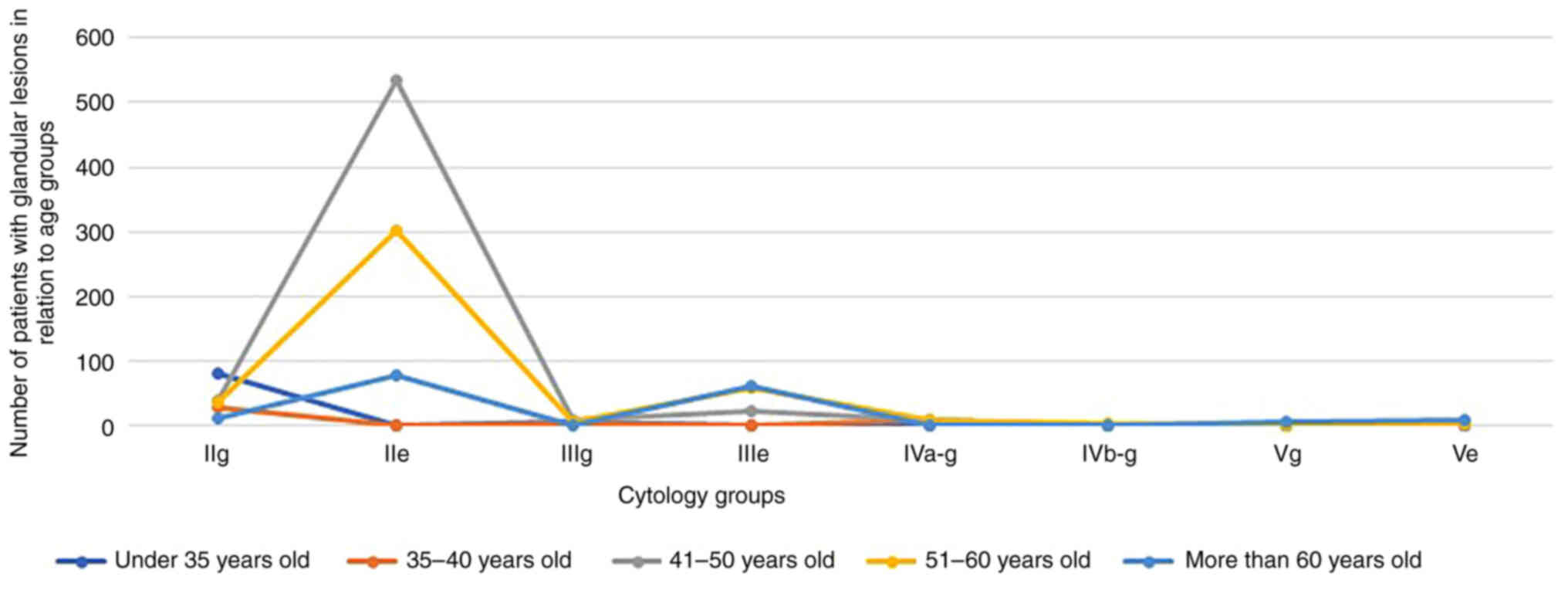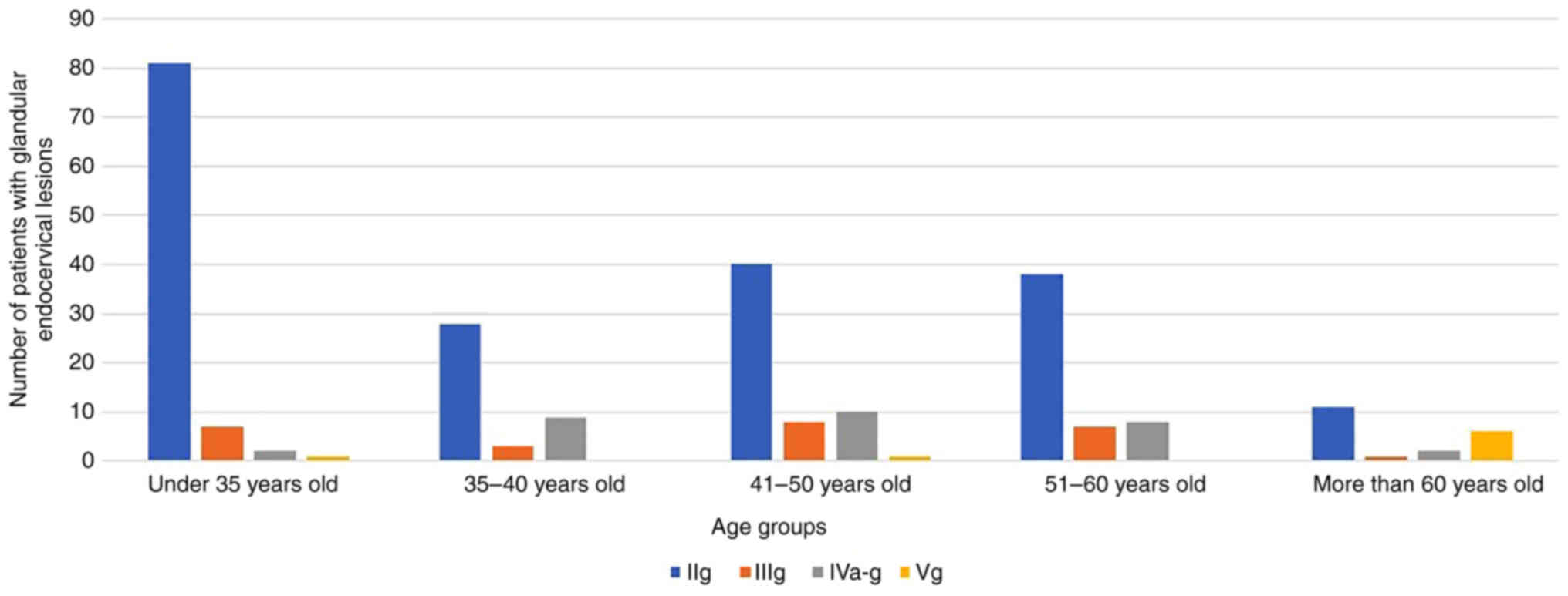|
1
|
Arbyn M, Weiderpass E, Bruni L, de Sanjosé
S, Saraiya M, Ferlay J and Bray F: Estimates of incidence and
mortality of cervical cancer in 2018: A worldwide analysis. Lancet
Glob Health. 8:e191–e203. 2020. View Article : Google Scholar : PubMed/NCBI
|
|
2
|
Sopracordevole F, Clemente N, Alessandrini
L, Di Giuseppe J, Cigolot F, Buttignol M, Ciavattini A and
Canzonieri V: Detection of occult endocervical glandular dysplasia
in cervical conization specimens for squamous lesions. Pathol Res
Pract. 213:210–216. 2017. View Article : Google Scholar : PubMed/NCBI
|
|
3
|
Teoh D, Musa F, Salani R, Huh W and
Jimenez E: Diagnosis and management of adenocarcinoma in situ: A
society of gynecologic oncology evidence-based review and
recommendations. Obstet Gynecol. 135:869–878. 2020. View Article : Google Scholar : PubMed/NCBI
|
|
4
|
Engineer AD and Misra JS: The role of
routine outpatient cytological screening for early detection of
carcinoma of the cervix in India. Diagn Cytopathol. 3:30–34. 1987.
View Article : Google Scholar : PubMed/NCBI
|
|
5
|
Ranabhat SK, Shrestha R and Tiwari M:
Analysis of abnormal epithelial lesions in cervical Pap smears in
Mid-Western Nepal. J Pathol Nepal. 1:30–33. 2011. View Article : Google Scholar
|
|
6
|
Graue R, Lönnberg S, Skare GB, Saether SMM
and Bjørge T: Atypical glandular lesions of the cervix and risk of
cervical cancer. Acta Obstet Gynecol Scand. 99:582–590. 2020.
View Article : Google Scholar : PubMed/NCBI
|
|
7
|
Marquardt K, Schenk U and Griesser H:
Muenchen classification for gynaecological cytological diagnoses.
Verband deutscher cytologisch tätiger Assistenten e.V., Langen.
2014.(In German).
|
|
8
|
Griesser H, Marquardt K, Jordan B, Kühn W,
Neis K, Neumann HH, Bollmann R, Pöschel B, Steiner PM and Schenck
U: Münchner nomenklatur III. Frauenarzt. 11:2–7. 2013.
|
|
9
|
Deutsche Krebsgesellschaft, Deutsche
Krebshilfe, AWMF, . S3-Leitlinie Prävention des Zervixkarzinoms.
Langversion 1.0-Dezember 2017. AWMF-Registernummer 015/027OL.
https://www.awmf.org/uploads/tx_szleitlinien/015-027OLl_Praevention_Zervixkarzinom_2018-01.pdf9–January.
2019
|
|
10
|
Hillemanns P: Krebsfrüherkennung:
Zervixkarzinom-doppelter paradigmenwechsel. Dtsch Arztebl.
113:A282–A285. 2016.
|
|
11
|
Schnatz PF, Guile M, O'Sullivan DM and
Sorosky JI: Clinical significance of atypical glandular cells on
cervical cytology. Obstet Gynecol. 107:701–708. 2006. View Article : Google Scholar : PubMed/NCBI
|
|
12
|
Risse EK, Ouwerkerk-Noordam E and Boon ME:
Endometrial cells in liquid-based cervical cytology: A diagnostic
pitfall solved by preparing cytohistology from the residual thin
layer sample. Acta Cytol. 55:327–333. 2011. View Article : Google Scholar : PubMed/NCBI
|
|
13
|
DeSimone CP, Day ME, Tovar MM, Dietrich CS
III, Eastham ML and Modesitt SC: Rate of pathology from atypical
glandular cell Pap tests classified by the Bethesda 2001
nomenclature. Obstet Gynecol. 107:1285–1291. 2006. View Article : Google Scholar : PubMed/NCBI
|
|
14
|
Marques JP, Costa LB, Pinto AP, Lima AF,
Duarte ME, Barbosa AP and Medeiros PL: Atypical glandular cells and
cervical cancer: Systematic review. Rev Assoc Med Bras (1992).
57:234–238. 2011. View Article : Google Scholar : PubMed/NCBI
|
|
15
|
Wang J, Andrae B, Sundström K, Ström P,
Ploner A, Elfström KM, Arnheim-Dahlström L, Dillner J and Sparén P:
Risk of invasive cervical cancer after atypical glandular cells in
cervical screening: Nationwide cohort study. BMJ. 352:i2762016.
View Article : Google Scholar : PubMed/NCBI
|
|
16
|
Pirog EC, Lloveras B, Molijn A, Tous S,
Guimerà N, Alejo M, Clavero O, Klaustermeier J, Jenkins D, Quint
WG, et al: HPV prevalence and genotypes in different histological
subtypes of cervical adenocarcinoma, a worldwide analysis of 760
cases. Mod Pathol. 27:1559–1567. 2014. View Article : Google Scholar : PubMed/NCBI
|
|
17
|
Holl K, Nowakowski AM, Powell N,
McCluggage WG, Pirog EC, Collas De Souza S, Tjalma WA, Rosenlund M,
Fiander A, Castro Sánchez M, et al: Human papillomavirus prevalence
and type-distribution in cervical glandular neoplasias: Results
from a European multinational epidemiological study. Int J Cancer.
137:2858–2868. 2015. View Article : Google Scholar : PubMed/NCBI
|
|
18
|
Ronnett BM, Manos MM, Ransley JE,
Fetterman BJ, Kinney WK, Hurley LB, Ngai JS, Kurman RJ and Sherman
ME: Atypical glandular cells of undetermined significance (AGUS):
Cytopathologic features, histopathologic results, and human
papillomavirus DNA detection. Hum Pathol. 30:816–825. 1999.
View Article : Google Scholar : PubMed/NCBI
|
|
19
|
Schiffmann M and de Sanjose S: False
positive cervical HPV screening test results. Papillomavirus Res.
7:184–187. 2019. View Article : Google Scholar : PubMed/NCBI
|
|
20
|
Clifford G and Franceschi S: Members of
the human papillomavirus type 18 family (alpha-7 species) share a
common association with adenocarcinoma of the cervix. Int J Cancer.
122:1684–1685. 2008. View Article : Google Scholar : PubMed/NCBI
|
|
21
|
Abbas M, de Jonge J and Bettendorf O:
HPV-genotyping versus conventional cervical cytology as a screening
method to detect dysplastic cervical epithelial changes. Sci Rep.
12:178282022. View Article : Google Scholar : PubMed/NCBI
|
















